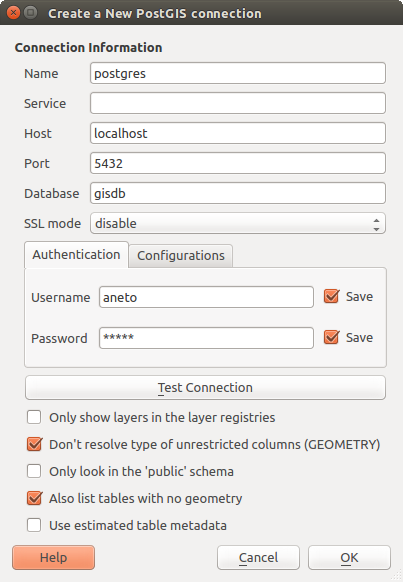Opening Data¶
As part of an Open Source Software ecosystem, QGIS is built upon different libraries that, combined with its own providers, offer capabilities to read and often write a lot of formats:
Vector data formats include ESRI formats (Shapefile, Geodatabase…), MapInfo and MicroStation file formats, AutoCAD DWG/DXF, GeoPackage, GeoJSON, GRASS, GPX, KML, Comma Separated Values, and many more… Read the complete list of OGR vector supported formats.
Raster data formats include ArcInfo Binary Grid, ArcInfo ASCII Grid, JPEG, GeoTIFF, ERDAS IMAGINE, MBTiles, R or Idrisi rasters, ASCII Gridded XYZ, GDAL Virtual, SRTM, Sentinel Data, and many more… Read the complete list of raster supported formats.
Database formats include PostgreSQL/PostGIS, SQLite/SpatiaLite, Oracle, DB2 or MSSQL Spatial, MySQL…
Support of web data services (WM(T)S, WFS, WCS, CSW, ArcGIS Servers…) is also handled by QGIS providers (see QGIS as OGC Data Client).
You can also read supported files from archived folders and use QGIS native formats such as virtual and memory layers.
As of the date of this document, more than 80 vector and 140 raster formats are supported by the GDAL/OGR and QGIS native providers.
Poznámka
Not all of the listed formats may work in QGIS for various reasons. For
example, some require external proprietary libraries, or the GDAL/OGR
installation of your OS may not have been built to support the format you
want to use. To see the list of available formats, run the command line
ogrinfo --formats (for vector) and gdalinfo --formats (for raster),
or check menu (for raster)
in QGIS.
In QGIS, depending on the data format, there are different tools to open it,
mainly available in the menu
or from the Manage Layers toolbar (enabled through menu).
However, all these tools point to a unique dialog, the Data Source
Manager dialog that you can directly open with the  Open Data Source Manager button available on the Data Source
Manager Toolbar or by pressing Ctrl+L. Indeed, the Data Source
Manager dialog offers a unified interface to open vector or raster file-based
data as well as databases or web services supported by QGIS. It can be set
modal or not with the
Open Data Source Manager button available on the Data Source
Manager Toolbar or by pressing Ctrl+L. Indeed, the Data Source
Manager dialog offers a unified interface to open vector or raster file-based
data as well as databases or web services supported by QGIS. It can be set
modal or not with the  Modeless data source manager dialog
in menu.
Modeless data source manager dialog
in menu.
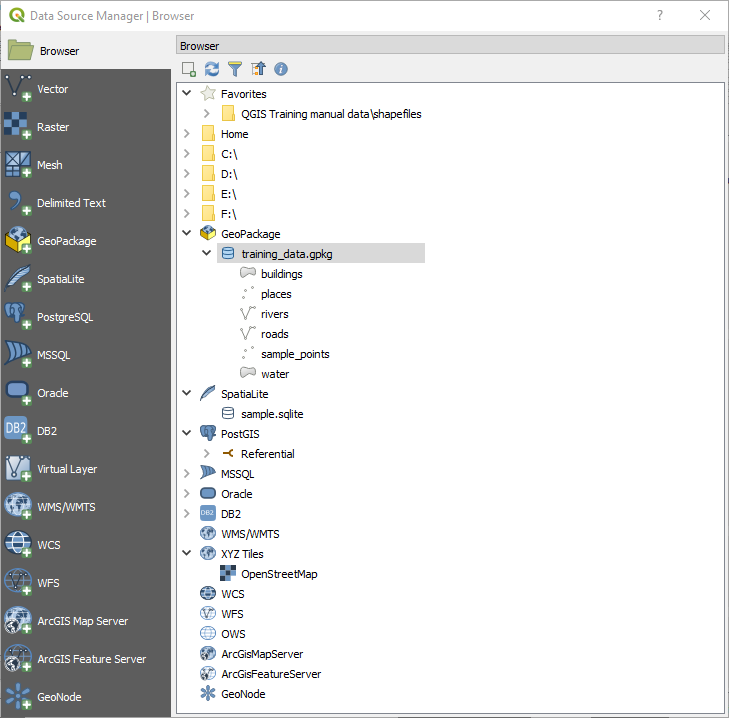
QGIS Data Source Manager dialog¶
Beside this main entry point, you also have the  DB Manager
plugin that offers advanced capabilities to analyze and manipulate connected
databases. More information on DB Manager capabilities are exposed in DB Manager Plugin.
DB Manager
plugin that offers advanced capabilities to analyze and manipulate connected
databases. More information on DB Manager capabilities are exposed in DB Manager Plugin.
There are also many other tools, native or third-party plugins, that help you open dedicated data formats.
This chapter will describe only the tools provided by default in QGIS to load data. It will mainly focus on the Data Source Manager dialog but more than describing each tab, it will also explore the tools based on the data provider or format specificities.
The Browser Panel¶
The Browser is one of the main ways to quickly and easily add your data to projects. It’s available as:
a Data Source Manager tab, enabled pressing the
 Open Data Source Manager button (Ctrl+L);
Open Data Source Manager button (Ctrl+L);as a QGIS panel you can open from the menu (or
 ) or by pressing Ctrl+2.
) or by pressing Ctrl+2.
In both cases, the Browser helps you navigate in your file system and manage geodata, regardless the type of layer (raster, vector, table), or the datasource format (plain or compressed files, database, web services).
The context menu for an element in the Browser panel is opened by right-clicking on it.
For file system directory entries, the context menu offers the following:
Add as a Favorite
Properties…
Hide from Browser
Fast Scan this Directory
New Directory…
Open Directory
Favourites, can also be removed and renamed:
Rename favourite…
Remove favourite
For leaf entries that can act as layers in the project, the context menu will have a selection of entries. For example, for non-database, non-service-based vector, raster and mesh data sources:
Add Selected Layer(s) to Canvas
Properties…
Delete File „<name of file>“…
In the Layer properties entry, you will find (similar to what you will find in the vector and raster layer properties once the layers have been added to the project):
Metadata for the layer. Metadata groups: Information from provider (if possible, Path will be a hyperlink to the source), Identification, Extent, Access, Fields (for vector layers), Bands (for raster layers), Contacts, Links (for vector layers), References (for raster layers), History.
A Preview panel
The attribute table for vector sources (in the Attributes panel).
To add a layer to the project using the Browser:
Enable the Browser as described above. A browser tree with your file system, databases and web services is displayed. You may need to connect databases and web services before they appear (see dedicated sections).
Find the layer in the list.
Use the context menu, double-click its name, or drag-and-drop it into the map canvas. Your layer is now added to the Layers panel and can be viewed on the map canvas.
Tip
Open a QGIS project directly from the browser
You can also open a QGIS project directly from the Browser panel by double-clicking its name or by drag-and-drop into the map canvas.
Once a file is loaded, you can zoom around it using the map navigation tools. To change the style of a layer, open the Layer Properties dialog by double clicking on the layer name or by right-clicking on the name in the legend and choosing from the context menu. See section Symbology Properties for more information on setting symbology of vector layers.
At the top of the Browser panel, you find some icons that help you to:
 Add Selected Layers: you can also add data into the map
canvas by selecting Add selected layer(s) from the layer’s context menu;
Add Selected Layers: you can also add data into the map
canvas by selecting Add selected layer(s) from the layer’s context menu; Filter Browser to search for specific data. Enter a search
word or wildcard and the browser will filter the tree to only show paths to
matching DB tables, filenames or folders – other data or folders won’t be
displayed. See the Browser Panel(2) example on the figure_browser_panels.
The comparison can be case-sensitive or not. It can also be set to:
Filter Browser to search for specific data. Enter a search
word or wildcard and the browser will filter the tree to only show paths to
matching DB tables, filenames or folders – other data or folders won’t be
displayed. See the Browser Panel(2) example on the figure_browser_panels.
The comparison can be case-sensitive or not. It can also be set to:normal: return any item containing the search text;
using wildcard(s): fine tune the search using
?and/or*characters to specify the position of the search text;using a regular expression.
 Enable/disable properties widget: when toggled on,
a new widget is added at the bottom of the panel showing, if applicable,
metadatas of the selected item.
Enable/disable properties widget: when toggled on,
a new widget is added at the bottom of the panel showing, if applicable,
metadatas of the selected item.
Right-click an item in the browser tree helps you to:
in case of file or table, display its metadata or open it in your project. Tables can even be renamed, deleted or truncated;
in case of folder, bookmark it into your favourites, hide it from the browser tree. Hidden folders can be managed from the tab;
create connection to databases or web servers;
refresh, rename or delete schema.
You can also import files into databases or copy tables from one schema/database to another one with a simple drag-and-drop. There is a second browser panel available to avoid long scrolling while dragging. Just select the file and drag-and-drop from one panel to the other.
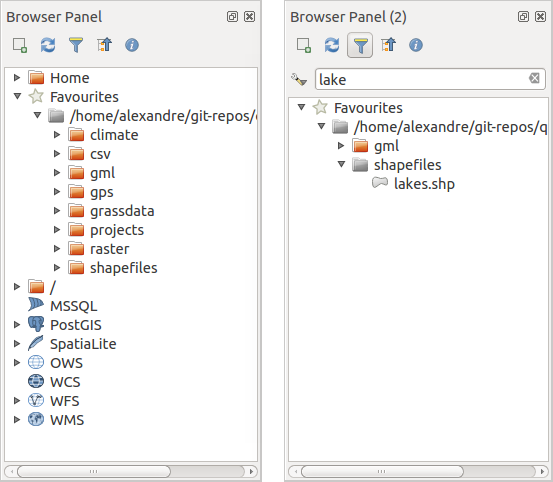
QGIS Browser panels side-by-side¶
Tip
Add layers to QGIS by simple drag-and-drop from your OS file browser
You can also add file(s) to the project by drag-and-dropping them from your operating system file browser to the Layers Panel or the map canvas.
The DB Manager¶
The DB Manager Plugin is another one of the main and native tools to integrate and manage spatial database formats supported by QGIS (PostGIS, SpatiaLite, GeoPackage, Oracle Spatial, MSSQL, DB2, Virtual layers) in one user interface. It can be activated from the menu.
The  DB Manager Plugin provides several features:
DB Manager Plugin provides several features:
connect to databases and display its structure and contents;
preview tables of databases;
add layers to map canvas, either by double-click or drag-and-drop;
add layers to a database from the QGIS Browser or from another database;
create and add output of SQL queries to the map canvas;
create virtual layers.
More information on DB Manager capabilities are exposed in DB Manager Plugin.
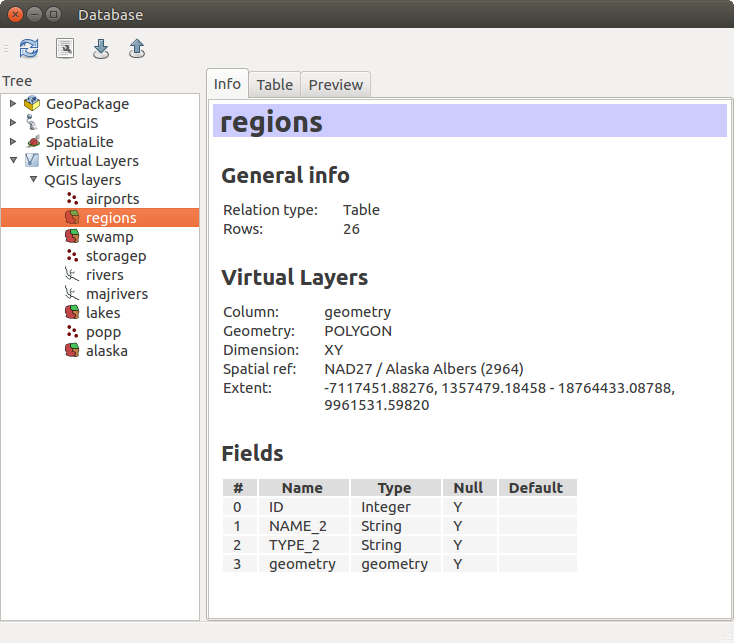
DB Manager dialog¶
Provider-based loading tools¶
Beside Browser Panel and DB Manager, the main tools provided by QGIS to add layers regardless the format, you’ll also find tools that are specific to data providers.
Poznámka
Some external plugins also propose tools to open specific format files in QGIS.
Loading a layer from a file¶
To load a layer from a file, you can:
for vector data (like Shapefile, Mapinfo or dxf layer), click on
 Add Vector Layer toolbar button, select the
Add Vector Layer toolbar button, select the
 Add Vector
Layer menu option or press Ctrl+Shift+V.
This will bring up a new window (see figure_vector_add) from which you can
check
Add Vector
Layer menu option or press Ctrl+Shift+V.
This will bring up a new window (see figure_vector_add) from which you can
check  File and click on Browse. You can
also specify the encoding for the file if desired.
File and click on Browse. You can
also specify the encoding for the file if desired.
Add Vector Layer Dialog¶
for raster layers, click on the
 Add Raster Layer icon,
select the
Add Raster Layer icon,
select the  Add Raster Layer menu option or type Ctrl+Shift+R.
Add Raster Layer menu option or type Ctrl+Shift+R.
That will bring up a standard open file dialog (see figure_vector_open), which
allows you to navigate the file system and load a shapefile, a geotiff or other
supported data source. The selection box Filter  allows you to preselect some supported file formats. Only the formats that have
been well tested appear in the list. Other untested formats can be loaded by
selecting
allows you to preselect some supported file formats. Only the formats that have
been well tested appear in the list. Other untested formats can be loaded by
selecting All files (*.*).
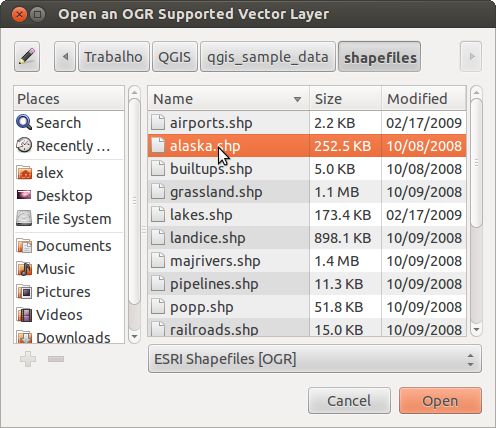
Open an OGR Supported Vector Layer Dialog¶
Selecting a file from the list and clicking Open loads it into QGIS.
More than one layer can be loaded at the same time by holding down the
Ctrl or Shift key and clicking on multiple items in the dialog.
Figure_vector_loaded shows QGIS after loading the alaska.shp file.
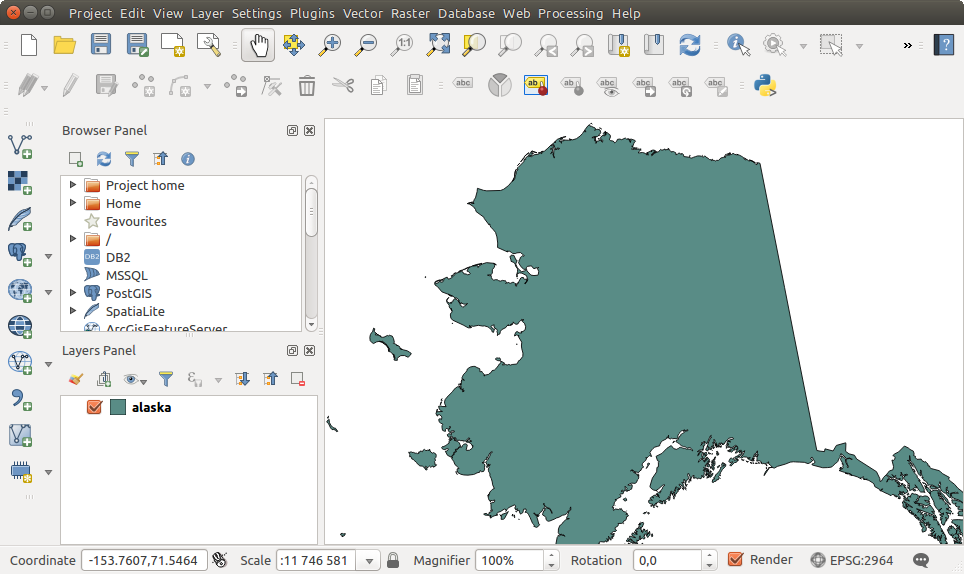
QGIS with Shapefile of Alaska loaded¶
Poznámka
Because some formats like MapInfo (e.g., .tab) or Autocad (.dxf)
allow mixing different types of geometry in a single file, loading such format
in QGIS opens a dialog to select geometries to use in order to have one
geometry per layer.
Using the  Add Vector Layer tool:
Add Vector Layer tool:
You can also load specific formats like
ArcInfo Binary Coverage,UK. National Transfer Format, as well as the raw TIGER format of theUS Census BureauorOpenfileGDB. To do that, you’d need to select Directory as Source type. In this case
a directory can be selected in the dialog after pressing Browse.
Directory as Source type. In this case
a directory can be selected in the dialog after pressing Browse.With the
 Database source type you can select an
existing database connection or create one to the selected database type.
Available database types are
Database source type you can select an
existing database connection or create one to the selected database type.
Available database types are ODBC,OGDI Vectors,Esri Personal Geodatabase,MySQLas well asPostgreSQLorMSSQL.Pressing the New button opens the Create a New OGR Database Connection dialog whose parameters are among the ones you can find in Creating a stored Connection. Pressing Open you can select from the available tables for example of the PostGIS enabled database.
The last source type,
 Protocol, enables to open
data from the web using for example
Protocol, enables to open
data from the web using for example GeoJSONorCouchDBformat. After selecting the type you have to fill URI of the source.
Tip
Load layers and projects from mounted external drives on macOS
On macOS, portable drives that are mounted beside the primary hard drive
do not show up as expected under .
We are working on a more macOS-native open/save dialog to fix this.
As a workaround, you can type /Volumes in the File name box
and press Enter. Then you can navigate to external drives and network
mounts.
Importing a delimited text file¶
Delimited text file (e.g. .csv, .txt) can be loaded in QGIS
using the tools described above. However, loaded this way, it’ll show up like a
simple table data. Sometimes, delimited text files can contain geometric data
you’d want to visualize; this is what the  Add
Delimited Text Layer is designed for.
Add
Delimited Text Layer is designed for.
Click the  Open Data Source Manager icon to open the
Data Source Manager dialog and enable the
Open Data Source Manager icon to open the
Data Source Manager dialog and enable the  Delimited Text tab, as shown in figure_delimited_text.
Delimited Text tab, as shown in figure_delimited_text.
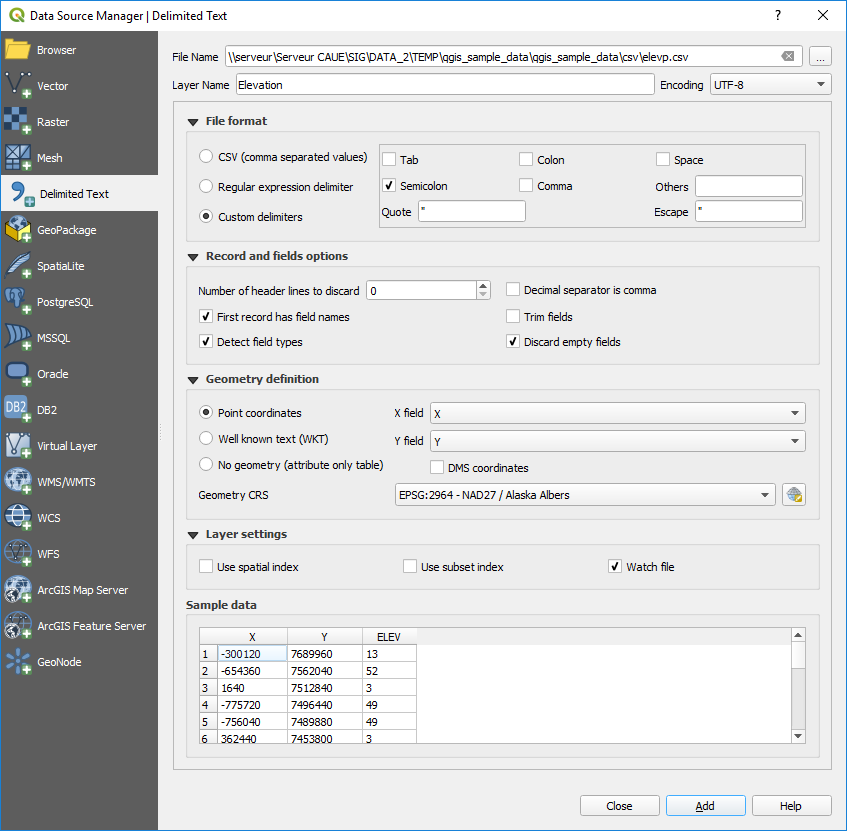
Delimited Text Dialog¶
First, select the file to import (e.g., qgis_sample_data/csv/elevp.csv)
by clicking on the Browse button. In the Layer name field,
provide the name to use for the layer in the project (e.g., Elevation).
File format¶
Once the file is selected, QGIS attempts to parse the file with the most recently used delimiter, trying to identify fields and rows. To enable QGIS to properly parse the file, it is important to select the correct delimiter. You can specify a delimiter by activating:
Records and fields¶
Other than settings to identify rows and fields in the data, some convenient options can be used to tweak the data recognition:
Number of header lines to discard: convenient when you want to avoid some lines to show in the import, either because those are blank lines or with another formatting.
 First records has field names: values in the first row
of data are used as field names, otherwise QGIS adds a fields row of a type
First records has field names: values in the first row
of data are used as field names, otherwise QGIS adds a fields row of a type
field_1,field_2… Detect field types: automatically recognizes the field
type. If unchecked then all attributes are treated as text fields.
Detect field types: automatically recognizes the field
type. If unchecked then all attributes are treated as text fields. Decimal separator is comma: if necessary, you can force
a comma to be the decimal separator.
Decimal separator is comma: if necessary, you can force
a comma to be the decimal separator. Trim fields: allows you to trim leading and trailing
spaces from fields.
Trim fields: allows you to trim leading and trailing
spaces from fields.
As you set the parser properties, a sample data preview updates at the bottom of the dialog.
Geometry definition¶
Once the file is parsed, set Geometry definition to
 Point coordinates and provide the X
field and Y field if the layer is of point geometry type and
contain such coordinate fields. If the coordinates are defined as
degrees/minutes/seconds, activate the
Point coordinates and provide the X
field and Y field if the layer is of point geometry type and
contain such coordinate fields. If the coordinates are defined as
degrees/minutes/seconds, activate the  DMS coordinates
checkbox;
DMS coordinates
checkbox; Well known text (WKT) option if the spatial
information is represented by WKT: select the Geometry field
containing the WKT definition and choose the approriate Geometry
field or let QGIS auto-detect it;
Well known text (WKT) option if the spatial
information is represented by WKT: select the Geometry field
containing the WKT definition and choose the approriate Geometry
field or let QGIS auto-detect it;If the file contains non-spatial data, activate
 No
geometry (attribute only table) and it will be loaded as an ordinary table.
No
geometry (attribute only table) and it will be loaded as an ordinary table.
Besides the features geometry information, you can also set the layer’s
Geometry CRS using the  Select CRS widget.
Select CRS widget.
Layer settings¶
Additionally, you can enable:
 Use spatial index to improve the performance of
displaying and spatially selecting features;
Use spatial index to improve the performance of
displaying and spatially selecting features; Use subset index to improve performance of subset
filters (when defined in the layer properties);
Use subset index to improve performance of subset
filters (when defined in the layer properties); Watch file to watch for changes to the file by other
applications while QGIS is running.
Watch file to watch for changes to the file by other
applications while QGIS is running.
At the end, click OK to add the layer to the map. In our example, a
point layer named Elevation is added to the project and behaves like any
other map layer in QGIS. However, this layer is the result of a query on the
.csv source layer (hence, linked to it) and would require to be
saved in order to get a spatial layer on disk.
Importing a DXF or DWG file¶
DXF and DWG files can be added to QGIS by simple drag-and-drop
from the common
Browser Panel. You’ll be prompted to select the sublayers you’d like to add
to the project. Layers are added with random style properties.
Poznámka
DXF files containing several geometry types (point, line and/or polygon), the name of the layer will be made from <filename.dxf> entities <geometry type>.
To keep the dxf/dwg file structure and its symbology in QGIS, you may want to use the dedicated tool which allows you to:
import elements from the drawing file into a GeoPackage database.
and add to the project any of the imported elements.
In the DWG/DXF Import dialog, to first import the drawing file contents:
Input the location of the Target package, i.e. the new GeoPackage file that will store the data. If an existing file is provided, then it will be overwritten.
Specify the coordinate reference system of the data in the drawing file.
Check
 Expand block references to import the
blocks in the drawing file as normal elements.
Expand block references to import the
blocks in the drawing file as normal elements.Check
 Use curves to promote the imported layers
to a
Use curves to promote the imported layers
to a curvedgeometry type.Use the Import button to select the DWG/DXF file to use (one per geopackage). The GeoPackage database will be automatically populated with the drawing file content. Depending on the size of the *CAD file, this could take some time.
After the .dwg or .dxf data is imported into the GeoPackage
database the frame in the lower half of the dialog is populated with the list of
layers from the imported file. There you can select which layers to add to the
QGIS project:
At the top, set a Group name to group the drawing files in the project.
Check layers to show: Each selected layer is added to an ad hoc group which contains vector layers for the point, line, label and area features of the drawing layer. The style of each layer is setup so that it resembles the look it originally had in *CAD.
Check whether layer should be visible at opening.
Alternatively using the
 Merge layers option places all
layers in a single group.
Merge layers option places all
layers in a single group.Press OK to open the layers in QGIS.
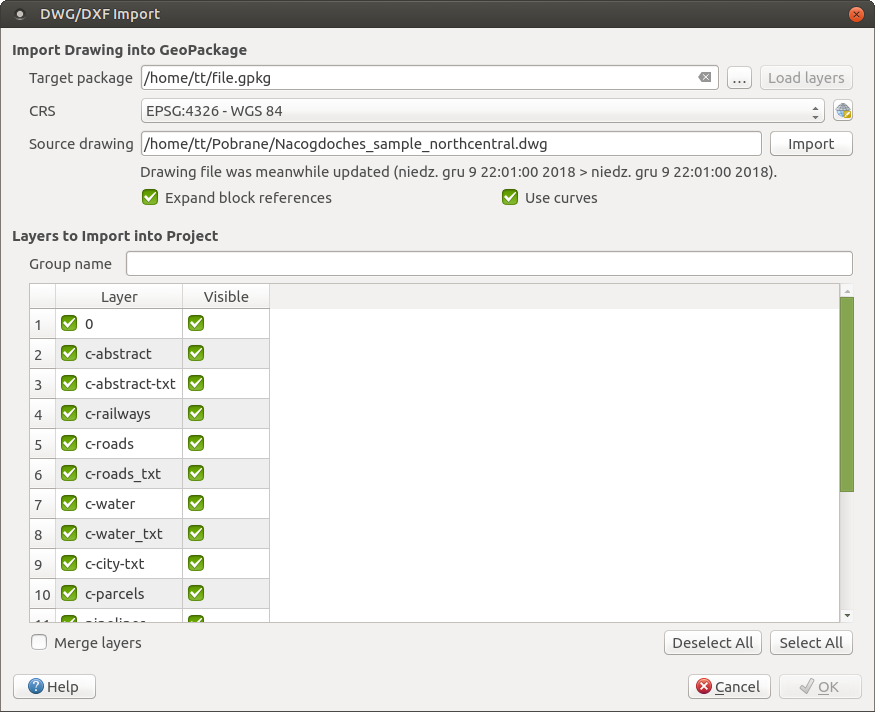
Import dialog for DWG/DXF files¶
Importing OpenStreetMap Vectors¶
In recent years, the OpenStreetMap project has gained popularity because in many countries no free geodata such as digital road maps are available. The objective of the OSM project is to create a free editable map of the world from GPS data, aerial photography or local knowledge. To support this objective, QGIS provides support for OSM data.
Using the Browser Panel, you can load a .osm file to the
map canvas, in which case you’ll get a dialog to select sublayers based on the
geometry type. The loaded layers will contain all the data of that geometry type
in the file and keep the osm file data structure.
SpatiaLite Layers¶
 The first time you load data from a SpatiaLite
database, begin by:
The first time you load data from a SpatiaLite
database, begin by:
or by typing Ctrl+Shift+L.
This will bring up a window that will allow you either to connect to a
SpatiaLite database already known to QGIS, which you can choose from the
drop-down menu, or to define a new connection to a new database. To define a
new connection, click on New and use the file browser to point to
your SpatiaLite database, which is a file with a .sqlite extension.
QGIS also supports editable views in SpatiaLite.
GPS¶
Loading GPS data in QGIS can be done using the core plugin: GPS Tools.
Instructions are described in Section GPS Plugin.
GRASS¶
Working with GRASS vector data is described in Section GRASS GIS Integration.
QGIS Custom formats¶
QGIS proposes two custom formats you can load in the application using their own loading tool:
Temporary Scratch Layer: a memory layer that is bound to the project it’s opened with (see Creating a new Temporary Scratch Layer for more information)
Virtual Layers: a layer resulting from a query on other layer(s) (see Creating virtual layers for more information)
QLR - QGIS Layer Definition File¶
Layer definitions can be saved as a
Layer Definition File (QLR -
.qlr) using
in the layer
context menu.
The QLR format makes it possible to share „complete“ QGIS layers with other QGIS users. QLR files contain links to the data sources and all the QGIS style information necessary to style the layer.
QLR files are shown in the Browser Panel and can be used to add layers (with their saved styles) to the Layers Panel. You can also drag and drop QLR files from the system file manager into the map canvas.
Connecting to web services¶
With QGIS you can have access to different types of OGC web services (WM(T)S, WFS(-T), CSW …). Thanks to QGIS Server, you can also publish these services. Description of these capabilities and how-to are provided in chapter Working with OGC Data.







